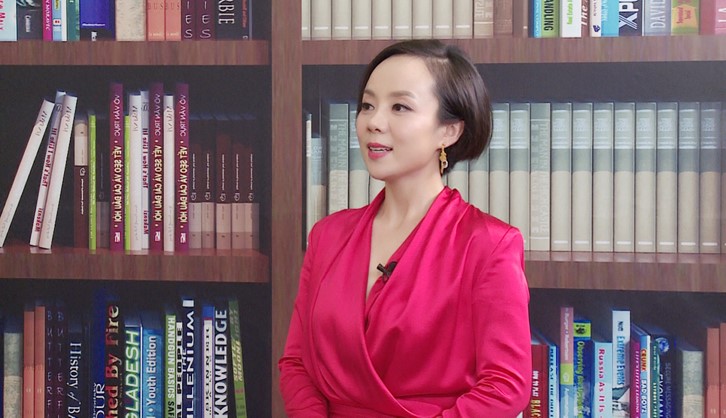
当前课程知识点:Fundamentals of Inorganic Materials Science > 5 Phase equilibrium > 5.5 Applications of binary phase diagrams > 5.5 Applications of binary phase diagrams
返回《Fundamentals of Inorganic Materials Science》慕课在线视频课程列表
返回《Fundamentals of Inorganic Materials Science》慕课在线视频列表
同学们好
前面
我们讲了8类二元系统相图的基本类型
这次课我们学习专业二元相图
我们通过四个专业相图的学习
了解二元系统相图在生产实际中的具体应用
首先我们学习CaO-SiO2系统二元相图
这么复杂的一个相图展现在大家面前
大家的第一感觉就是学了8类基础相图
看到这个相图时
观察到里面有分相的帽型区
又有晶型转变线
还有不一致熔融化合物
不知道如何分析了
那么我们将给大家列出分析的思路及重点
分析这个相图
要求大家学会划分分二元系统
然后指出各无变量点的性质
针对硅砖生产
解释为什么CaO可作为硅砖生产的矿化剂
针对水泥生产
解释为什么硅酸盐水泥生产上采取急冷措施
最后学会如何应用相图指导实际生产
首先我们看如何划分分二元系统
在学习基础相图的时候
我们讲过
一致熔融化合物可以对相图进行分解
那么我们就看一下
系统中生成几个化合物
以及各化合物的性质
我们说过生成几个化合物
两个纵坐标间就有几条竖线
那么这个相图中就是生成了四个化合物
接下来再判断哪几个化合物是一致的
我们知道
如果化合物的组成线
在它的液相线对应的组成范围内
就是一致的
所以相图中
硅灰石和硅酸二钙是一致熔化合物
硅钙石和硅酸三钙是不一致熔化合物
因此
CaO-SiO2系统可以划分成
SiO2-CS
CS-C2S
C2S-CaO三个分二元系统
先讨论相图左侧的SiO2-CS分二元系统
在此分二元系统的富硅液相部分
有一个分液区
C点是此分二元系统的低共熔点
温度为1436℃
含37%的CaO
学习SiO2单元系统相图时
我们知道硅砖生产时
可以加入氧化钙作为矿化剂
促进鳞石英的生成
现在我们来解释一下
氧化钙的加入会不会影响硅砖的耐火度
我们计算一个特殊温度
低共熔温度1436℃下所产生的液相量
用杠杆规则计算
向SiO2中加入1%CaO
生成的液相量为1:37
计算得2.7%
这个液相量不是很大
但我们取的是一个特殊温度
其他温度下液相量会不会很大呢
我们看到液相线CB较陡峭
还是通过杠杆规则
我们可以得出
温度升高时
液相量的增加也不会很多
这就保证了硅砖的高耐火度
最右侧的是C2S-CaO分二元系统
含有硅酸盐水泥的重要矿物C2S和C3S
C3S是一个不一致熔化合物
仅能稳定存在于1250℃~2150℃的温度区间
超出这个温度区间就会分解
通过右图还可以看出
C2S有较为复杂的晶型转变
在冷却过程中
β-C2S在525转变为稳定态γ-C2S
C3S和β-C2S是硅酸盐水泥中的二种水硬性矿物
但当水泥熟料缓慢冷却时
C3S将会分解
β-C2S将转变为无水硬活性的γ-C2S
为了避免这种情况的发生
生产上可以采取急冷措施
这样
C3S和β-C2S迅速越过分解温度
或晶型转变温度
在低温下以介稳态保存下来
我们再来看铝硅二元系统相图
学习要求和上一相图类似
不再重复
我们看到在这个相图里
纵坐标之间有两条竖线
但是要注意的是
这只是生成了一个一致熔化合物A3S2
就是莫来石
莫来石中可以固溶少量Al2O3
莫来石是普通陶瓷及粘土质耐火材料中的重要矿物
在A3S2-Al2O3分二元系统中
A3S2熔点为1850℃
Al2O3熔点2050℃
因此
莫来石质及刚玉质耐火砖
都是性能优良的耐火材料
刚才我们讲了
可以加入氧化钙作为硅砖生产的矿化剂
如果加入Al2O3作为矿化剂
会不会影响硅砖的耐火度呢
如果在SiO2中加入l% Al2O3
根据杠杆规则
仍然计算低共熔点温度1595℃下的液相量
为1比5.5
等于18.2
这个液相量就比较大了
这样就会使硅砖的耐火度大大下降
另外
由于与SiO2平衡的液相线
从SiO2熔点1723℃向E1点迅速下降
Al2O3的加入必然造成
硅砖熔化温度的急剧下降
因此对硅砖来说
Al2O3是非常有害的杂质
在硅砖的制造和使用过程中
要严防Al2O3的混入
这个是MgO-SiO2系统相图
系统中有一个一致熔化合物M2S
镁橄榄石
还有一个不一致熔化合物MS顽火辉石
大家可以自己试着
对其中各无变量点的性质加以分析
需要强调的是
镁质耐火材料配料中MgO含量
应大于镁橄榄石中MgO含量
否则配料点落入镁橄榄石-SiO2系统
开始出现液相温度及全融温度急剧下降
造成耐火度的急剧下降
而且实际应用中
镁质砖与硅质砖不能混用
否则共熔点下降
最后我们介绍Na2O-SiO2系统相图
由于在碱含量高时熔融碱的挥发
以及熔融物的腐蚀性很强
所以在实验中
Na2O的摩尔分数只取0%~67%
故相图中缺乏Na2O含量高部分
这个相图我们强调一个知识点
就是在该相图富含SiO2的地方
有一个介稳的二液区
就是虚线表示的区域
组成在这个范围的熔体较高温度下会分相
使玻璃变得乳浊
这个知识点我们介绍了四个专业相图
希望大家能够掌握专业相图的分析方法
同学们再见
-Test for chapter 1
-2.1 Type of defect
-2.2.1 The expression methods of point defects
--2.2.1 The expression methods of point defects
--2.2.1 The expression methods of point defects
-2.2.2 The rules for writing of defect reaction equation
--2.2.2 The rules for writing of defect reaction equation
--2.2.2 The rules for writing of defect reaction equation
-2.3 Calculation of thermal defect concentration
--2.3 Calculation of thermal defect concentration
--2.3 Calculation of thermal defect concentration
-2.4 Non-stoichiometric compounds
--2.4 Non-stoichiometric compounds
--2.4 Non-stoichiometric compounds
-Homework for chapter 2
-Test for chapter 2
-3.1 The classification of solid solutions
--3.1 The classification of solid solutions
--3.1 The classification of solid solutions
-3.2 Substitutional solid solution
--3.2 Substitutional solid solution
--3.2 Substitutional solid solution
-3.3 Interstitial solid solution
--3.3 Interstitial solid solution
--3.3 Interstitial solid solution
-3.4 The research method of solid solutions
--3.4 The research method of solid solutions
--3.4 The research method of solid solutions
-3.5 Questions for crystal imperfection and solid solution
--Questions for crystal imperfection and solid solution
-Homework for chapter 3
-Test for chapter 3
-4.1 Melt structure
-4.2 The properties of the melt
--4.2.1 The properties of the melt_viscosity
--4.2.2 The properties of the melt_surface tension
--4.2 The properties of the melt
-4.3 The characteristics of glass
--4.3 The characteristics of glass
--4.3 The characteristics of glass
-4.4 The formation of glass
--4.4.1 The formation of glass_kinetics conditions
--4.4.2 The formation of glass_crystal chemical conditions
-4.5 The structure of glass
-4.6 The typical glass
-4.7 Questions for melt and glass
--Questions for melt and glass
-Test for chapter 4
-5.1 Phase equilibrium in silicate systems
--5.1 Phase equilibrium in silicate system
--5.1 Phase equilibrium in silicate system
-5.2 One-component system phase diagram
--5.2 One-component system phase diagram
--5.2 One-component system phase diagram
-5.3 Applications of one-component diagrams
--5.3 Applications of one-component diagrams
--5.3 Applications of one-component diagrams
-5.4 Binary diagrams
--5.4.1 Binary diagram with eutectic point
--5.4.2 Binary system with a congruent melting compound and one with an incongruent melting compound
--5.4.3 Other five types of phase diagrams of binary systems
-5.5 Applications of binary phase diagrams
--5.5 Applications of binary phase diagrams
--5.5 Applications of binary phase diagrams
-5.6 Ternary diagrams
--5.6.1 Representation of ternary system composition
--5.6.1 Representation of ternary system composition
--5.6.2 Three-dimensional state diagram and plane projection diagram of a simple ternary system
--5.6.2 Three-dimensional state diagram and plane projection diagram of a simple ternary system
--5.6.3 (1) Basic types of ternary phase diagrams
--5.6.3 (2) Basic types of ternary phase diagrams
--5.6.3 (3) Basic types of ternary phase diagrams
--5.6.3 Basic types of ternary phase diagrams
-5.7 Applications of ternary phase diagrams
--5.7 Applications of ternary phase diagrams
--5.7 Applications of ternary phase diagrams
-5.8 Research methods of phase equilibrium
--5.8 Research methods of phase equilibrium
--5.8 Research methods of phase equilibrium
-5.9 Questions for phase equilibria
--Questions for phase equilibria
-Homework for chaper 5
-Test for chapter 5
-6.1 Overview of diffusion
-6.2 The kinetic equations of diffusion
--6.2 The kinetic equations of diffusion
--6.2 The kinetic equations of diffusion
-6.3 The thermodynamic equation of diffusion
--6.3 The thermodynamic equation of diffusion
--6.3 The thermodynamic equation of diffusion
-6.4 Diffusion mechanisms and diffusion coefficient
--6.4 Diffusion mechanisms and diffusion coefficient
--6.4 Diffusion mechanisms and diffusion coefficient
-6.5 Diffusion in solid
-6.6 Factors affecting diffusion
--6.6 Factors affecting diffusion
--6.6 Factors affecting diffusion
-6.7 Questions for diffusion
-Homework for chaper 6
-Test for chapter 6
-7.1 Overview of solid state reactions
--7.1 Overview of solid state reactions
--7.1 Overview of solid state reactions
-7.2 Kinetic equation of solid state reaction
--7.2 Kinetic equation of solid state reaction
-7.3 Factors affecting the solid state reaction
--7.3 Factors affecting the solid state reaction
--7.3 Factors affecting the solid state reaction
-Homeword for chapter 7
-8.1 The categories of phase transformation
--8.1 The categories of phase transformation
--8.1 The categories of phase transformation
-8.2 Crystallization
--8.2.1 Crystallization thermodynamics
--8.2.2 Crystallization kinetics
-8.3 Phase Separation of glass
--8.3 Phase separation of glass
--8.3 Phase separation of glass
-8.4 Questions for phase transformation
--Questions for phase transformation
-Test for chapter 8
-9.1 Overview of sintering
-9.2 The driving forces and models of sintering
--9.2 The driving forces and models of sintering
--9.2 The driving forces and models of sintering
-9.3 Solid state sintering
--9.3.1 Evaporation-Condensation mass transfer
--9.3.2 Diffusion mass transfer
-9.4 Liquid phase sintering
--9.4.2 Solution-Precipitation mass transfer
-9.5 Grain growth and secondary recrystallization
--9.5.2 Secondary recrystallization
--9.5 Grain growth and secondary recrystallization
-9.6 Factors affecting sintering
--9.6 Factors affecting sintering
--9.6 Factors affecting sintering
-9.7 Questions for sintering
-Homework for chapter 9
-Test for chapter 9



